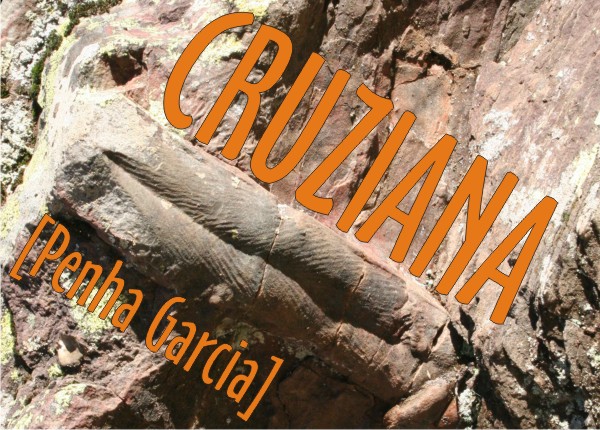
 Esta cache leva-lo-á até Penha Garcia, uma pequena povoação no coração do Geoparque Naturtejo, e até ao trilho PR3 – Rota dos fósseis.
Esta cache leva-lo-á até Penha Garcia, uma pequena povoação no coração do Geoparque Naturtejo, e até ao trilho PR3 – Rota dos fósseis.
Ao longo deste trilho, no canhão fluvial do rio Ponsul, o visitante poderá encontrar inúmeros afloramentos de quartzitos que contém bonitos espécimes de icnofósseis de trilobite: Cruziana!
Para reclamar a cache será necessário encontrar um destes bonitos icnofósseis e fazer um pequeno esboço ou tirar uma fotografia, indicando o sentido de movimento da trilobite que lhe deu origem.
Por favor enviem-me por mail a resposta (com a indicação do username) antes de efectuarem o log na página da cache.
Não coloquem imagens com a resposta nos logs, ainda que possam e devam colocar muitas fotografias sem a resposta :-D
A zona de Penha Garcia apresenta características únicas a múltiplos níveis, de onde se destaca o seu Parque Icnológico, com as suas as jazidas com fósseis e icnofósseis, reminiscências evolutivas importantes com mais de 480 milhões de anos. Pode também ser visitado o canhão fluvial do Ponsul, que atravessa a crista quartzítica encimada pelo castelo templário de Penha 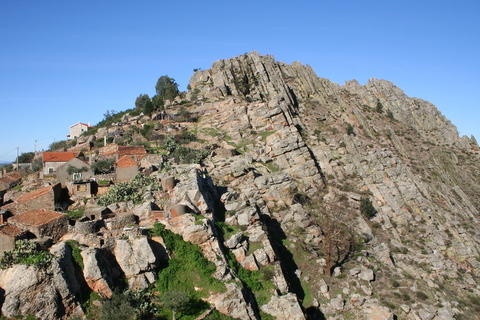 Garcia, que é uma verdadeira sala de aula na natureza, com um leque completo de aspectos passíveis de serem analisados por todos, com fácil acessibilidade e durante todo o ano. As suas serras quartzíticas são um oásis para a biodiversidade, onde proliferam ecossistemas que se encontram em vias de extinção. Tudo isto é possível observar através da realização do percurso pedestre Via Ichnologica (PR3 – Rota dos Fósseis), onde, se o desejar, poderá praticar simultaneamente alguns desportos de aventura como escalada, rappel ou slide.
Garcia, que é uma verdadeira sala de aula na natureza, com um leque completo de aspectos passíveis de serem analisados por todos, com fácil acessibilidade e durante todo o ano. As suas serras quartzíticas são um oásis para a biodiversidade, onde proliferam ecossistemas que se encontram em vias de extinção. Tudo isto é possível observar através da realização do percurso pedestre Via Ichnologica (PR3 – Rota dos Fósseis), onde, se o desejar, poderá praticar simultaneamente alguns desportos de aventura como escalada, rappel ou slide.
O que são icnofósseis?
Os icnofósseis são marcas representativas da actividade de animais, preservadas no substrato rochoso. Estes podem fornecer pistas intrigantes sobre a ecologia e o comportamento de animais já extintos, como é o exemplo das trilobites. Os animais raramente são encontrados em associação directa com os icnofósseis por eles criados mas, quando essa associação ocorre, permite aos cientistas estabelecer uma ligação entre os icnofósseis e as espécies que os criaram. De entre os inúmeros tipos de icnofósseis conhecidos, existem três categorias principais associadas com as trilobites: Rusophycus, Cruziana, e Diplichnites.
Os icnofósseis e a movimentação das trilobites
Quando uma trilobite se encontra imobilizada, parcialmente enterrada na superfície argilosa do fundo marinho, deixa uma impressão bi-lobada chamada Rusophycus, que por vezes apresenta as marcas paralelas deixadas pelas suas pernas. Cruziana são marcas longitudinais deixadas por uma trilobite enquanto se movimentava, parcialmente enterrada, através da lama. A parte mais larga da sua carapaça deixou as marcas laterais enquanto que o movimento das pernas deixou as marcas em forma de "V" no centro do rasto. Finalmente, quando a trilobite se começa a movimentar livremente sobre o fundo marinho, deixa pegadas chamadas Diplichnites, que se podem tornar cada vez mais espaçadas, à medida que a velocidade de locomoção aumenta. Como se pode observar na ilustração (sense of movement), os três tipos de marcas podem evoluir de uns para os outros, conforme a trilobite se encontra parada, se movimenta parcialmente enterrada ou livremente sobre o fundo.
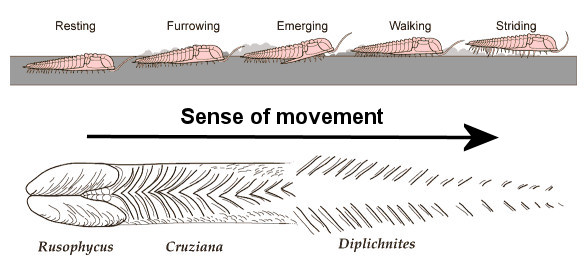
Os icnofósseis e a alimentação
Por vezes os icnofósseis mostram evidências de como as trilobites caçavam ou se alimentavam. Muitas cruziana são interpretadas como pistas de alimentação porque, para as criarem, as trilobites estar-se-iam a movimentar lentamente através do fundo oceânico, como se procurassem algo. Existem algumas cruziana que mostram sucessivas mudanças de direcção das trilobites até encontrarem uma presa, podendo então ocorrer marcas de luta que indicam que a trilobite terá capturado e comido a sua presa.
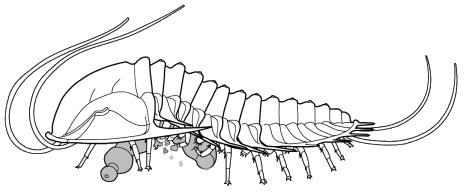
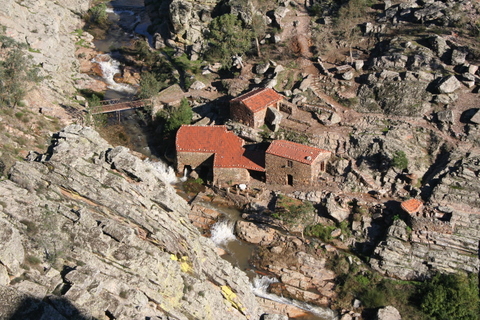
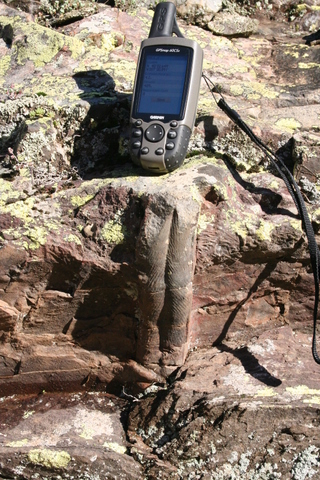


 This cache will take you to Penha Garcia, a small village within the Naturtejo Geopark, and to the PR3 trail – Fossils route.
This cache will take you to Penha Garcia, a small village within the Naturtejo Geopark, and to the PR3 trail – Fossils route.
Along this trail in the Ponsul canyon you will find several outcrops of quartzite that contain beautiful specimens of trilobite ichnofossils: Cruziana.
What I need you to do in order to claim this earthcache is to find some beautiful Cruziana, make a sketch or take a photo of it, and then tell me what was the sense of movement of the trilobite that produced these tracks.
Please do not place any photo with the answer in the log and e-mail me the answer (with your username) before logging your find.
The Penha Garcia area exhibits a variety of striking characteristics at multiple levels but particularly in what concerns the occurrence of a plethora of fossils and ichnofossils.
The Ponsul canyon, located within the synclinal feature of Penha Garcia, is another feature that can be easily seen from the Penha Garcia castle that sits atop the quartzite ridge that forms the southern flank of the syncline.
There are is also a rich treasure trove of a variety of ecosystems that are easily accessed by the PR3 trail –Fossils route.
A variety of radical sports, such as rock climbing, absailing and slide, are also available to the visitor
What are ichnofossils?
They are trace fossils: preserved tracks or other signs of the behaviour of animals in the substrate. Ichnofossils can provide some very intriguing insights on the ecology and behaviour of an extinct animal such as a trilobite. It is very rare that the animal itself is found in direct association with the ichnofossil it created, but that kind of co-occurrence allows scientists to link ichnofossils with the species that created them.  While there are hundreds of named ichnofossil types, there are threemain named categories of ichnofossils associated with trilobites: Rusophycus, Cruziana, and Diplichnites.
While there are hundreds of named ichnofossil types, there are threemain named categories of ichnofossils associated with trilobites: Rusophycus, Cruziana, and Diplichnites.
Ichnofossils and trilobite movement
When a trilobite is resting, partially buried in the mud of the benthos, it leaves a bi-lobed impression called a Rusophycus, that is sometimes marked by parallel marks that correspond to its legs. Cruziana are tracks showing rather clearly defined edge furrows, probably created by a trilobite moving, partially buried, through the mud. The widest part of the shell leaves the parallel outer furrows, while the leg movements create the chevron-shaped marks in the center of the track. Finally, when a trilobite is walking or striding freely upon the surface, it leaves paired leg marks called Diplichnites, which can be reduced to rather widely-spaced impressions when the animal is striding at full speed across the substrate. As noted in the illustration (sense of movement), the three types of traces can grade into one another, and the transitions are related to whether the animal is stationary or moving, the speed of movement, and whether the trilobite is partially buried or fully emerged from the substrate.
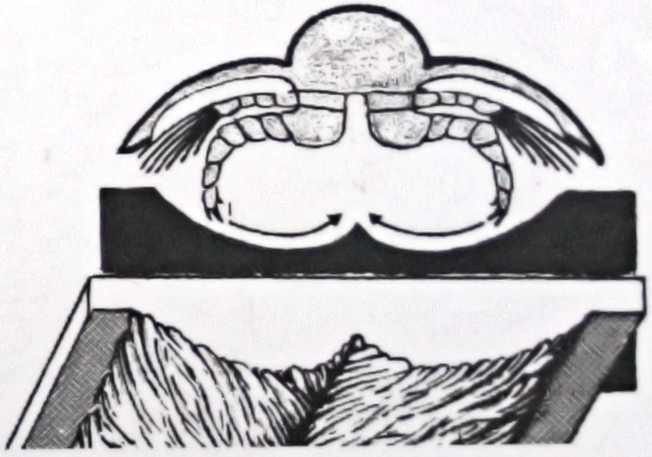
Ichnofossils and Feeding
Sometimes trace fossils leave evidence of how trilobites hunted or fed. Many Cruziana are thought of as feeding tracks, since to create them, the trilobite would be moving rather slowly through the upper layers of the ocean floor, as if searching for something. There have been some key specimens that show Cruziana changing direction toward a worm burrow, then stopping when it presumably intersected with the worm. Struggle marks at the end of the Cruziana track indicate that the trilobite captured and ate the worm.
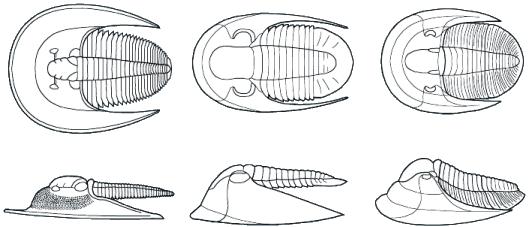
Referencias / References:
http://www.naturtejo.com/conteudos/pt/geo_sitios_2.php
http://www.trilobites.info/trace.htm

|
Diverte-te com as earthcaches!
A forma mais entusiasmante de aprender algo sobre a terra e os processos que a envolvem é sair para o campo e observar e experimentar em primeira mão o que esta tem para nos mostrar e ensinar. Uma earthcache está associada a um local especial, onde os seus visitantes tomarão contacto com algumas das características geológicas particulares que caracterizam o nosso planeta. Estas caches incluem um conjunto de informação pedagógica que, por exemplo, ajudará os seus visitantes a compreenderem os registos geológicos do nosso planeta, como este é modelado pelos processos geológicos ou como os cientistas recolhem a informação necessária ao estudo da terra. Poderás aprender mais AQUI (apenas em inglês)
|
|
Happy earthcaching!
The most exciting way to learn about the Earth and its processes is to get into the outdoors and experience it first-hand. Visiting an Earthcache is a great outdoor activity the whole family can enjoy. An Earthcache is a special place that people can visit to learn about a unique geoscience feature or aspect of our Earth. Earthcaches include a set of educational notes and the details about where to find the location (latitude and longitude). Visitors to Earthcaches can see how our planet has been shaped by geological processes, how we manage the resources and how scientists gather evidence to learn about the Earth. To find out more click HERE.
|
